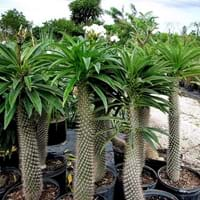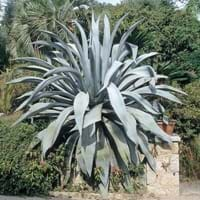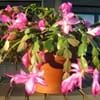Life Span
Perennial
Perennial
Type
Cactus or Succulent, Ornamental Plants, Perennial
Ornamental Plants
Types
P. ambongense P. baronii P. bicolor P. bispinosum P. brevicaule P. cactipes P. decaryi P. densiflorum P. eburneum P. geayi P. gracilius
Not Available
Habitat
Rocky areas, Tropical areas
Low annual rainfall regions, Semi desert
USDA Hardiness Zone
9-12
10-12
Sunset Zone
H1, H2, 13, 21, 22, 23, 24
Not Available
Habit
Upright/Erect
Rosette/Stemless
Flower Color
White
Yellow
Flower Color Modifier
Not Available
Not Available
Fruit Color
Gray Green, Tan
Non Fruiting Plant
Leaf Color in Spring
Green, Dark Green
Blue Green
Leaf Color in Summer
Green, Dark Green
Blue Green
Leaf Color in Fall
Dark Green
Blue Green
Leaf Color in Winter
Not Available
Blue Green
Leaf Shape
Long Narrow
Sword-like
Plant Season
Spring, Summer, Fall, Winter
Spring, Summer, Fall, Winter
Sunlight
Full Sun
Full Sun
Growth Rate
Medium
Medium
Type of Soil
Sand
Loam, Sand
The pH of Soil
Acidic, Neutral, Alkaline
Neutral, Alkaline
Soil Drainage
Well drained
Well drained
Bloom Time
Late Spring, Early Summer, Summer
Indeterminate
Tolerances
Drought
Drought
Where to Plant?
Container, Ground, Pot
Container, Ground
How to Plant?
Seedlings, Stem Cutting
Cuttings, Divison
Plant Maintenance
Medium
Medium
Watering Requirements
Drought Tolerant, Reduce watering in winter
Needs small amount of water
In Summer
Lots of watering
Lots of watering
In Spring
Moderate
Moderate
In Winter
Average Water
Average Water
Soil pH
Acidic, Neutral, Alkaline
Neutral, Alkaline
Soil Type
Loam, Moist, Sand, Well drained
Loam, Sand
Soil Drainage Capacity
Well drained
Well drained
Sun Exposure
Full Sun
Full Sun
Pruning
Prune in winter, Prune to stimulate growth, Remove damaged leaves, Remove dead branches, Remove dead leaves
Remove damaged leaves, Remove dead branches, Remove dead leaves
Fertilizers
All-Purpose Liquid Fertilizer, Fertilize in early spring, fertilize in early summer
All-Purpose Liquid Fertilizer
Pests and Diseases
Aphids, Dry root rot
Black spots, Brown Spots, Rots, Snout weevils
Plant Tolerance
Drought
Drought
Flower Petal Number
Single
Not Available
Fragrant Bark/Stem
Not Available
No
Foliage Texture
Bold
Bold
Foliage Sheen
Glossy
Matte
Attracts
Not Available
Not Available
Allergy
poisonous if ingested, Toxic
Antibacterial, Anti-inflammatory
Aesthetic Uses
along a porch, deck or patio, Beautification, Borders, Showy Purposes
Wild gardens
Beauty Benefits
Not Available
Not Available
Edible Uses
Not Available
Sometimes
Environmental Uses
Air purification
Air purification
Medicinal Uses
Not Available
Burns, Cuts, Diarrhea, Digestion problems, Dysentry, Skin irritation
Part of Plant Used
Not Applicable
Leaves, Root
Other Uses
Decoration Purposes, Showy Purposes
Used for making soaps
Used As Indoor Plant
Sometimes
No
Used As Outdoor Plant
Yes
Yes
Garden Design
Container, Feature Plant, Mixed Border, Rock Garden, Wall, Tropical
Container, Feature Plant, Mixed Border, Rock Garden, Wall, Tropical, Wildflower
Botanical Name
PACHYPODIUM lamerei
AGAVE gypsophila
Common Name
Madagascar Palm, Club Foot
American aloe, Century Plant, Maguey
In Hindi
Madagascar palm
सदी संयंत्र
In German
Madagaskarpalme
Jahrhundert-Anlage
In French
Pachypodium de Madagascar
Century Plant
In Spanish
Palma de Madagascar
Planta de siglo
In Greek
Pachypodium
αιώνα φυτών
In Portuguese
Palmeirinha-de-madagáscar, Palmeira-de-madagáscar
Century Plant
In Polish
Pachypodium
Century Plant
In Latin
Mandacaru
Century Plant
Phylum
Magnoliophyta
Magnoliophyta
Class
Dicotyledonae
Liliopsida
Order
Gentianales
Asparagales
Family
Apocynaceae
Agavaceae
Clade
Angiosperms, Asterids, Eudicots
Angiosperms, Monocots
Tribe
Malouetieae
Not Available
Subfamily
Apocynoideae
Agavoideae
Season and Care of Madagascar palm and Century Plant
Season and care of Madagascar palm and Century Plant is important to know. While considering everything about Madagascar palm and Century Plant Care, growing season is an essential factor. Madagascar palm season is Spring, Summer, Fall and Winter and Century Plant season is Spring, Summer, Fall and Winter. The type of soil for Madagascar palm is Sand and for Century Plant is Loam, Sand while the PH of soil for Madagascar palm is Acidic, Neutral, Alkaline and for Century Plant is Neutral, Alkaline.
Madagascar palm and Century Plant Physical Information
Madagascar palm and Century Plant physical information is very important for comparison. Madagascar palm height is 370.00 cm and width 90.00 cm whereas Century Plant height is 60.00 cm and width 60.00 cm. The color specification of Madagascar palm and Century Plant are as follows:
Madagascar palm flower color: White
Madagascar palm leaf color: Green and Dark Green
Century Plant flower color: Yellow
- Century Plant leaf color: Blue Green
Care of Madagascar palm and Century Plant
Care of Madagascar palm and Century Plant include pruning, fertilizers, watering etc. Madagascar palm pruning is done Prune in winter, Prune to stimulate growth, Remove damaged leaves, Remove dead branches and Remove dead leaves and Century Plant pruning is done Remove damaged leaves, Remove dead branches and Remove dead leaves. In summer Madagascar palm needs Lots of watering and in winter, it needs Average Water. Whereas, in summer Century Plant needs Lots of watering and in winter, it needs Average Water.





